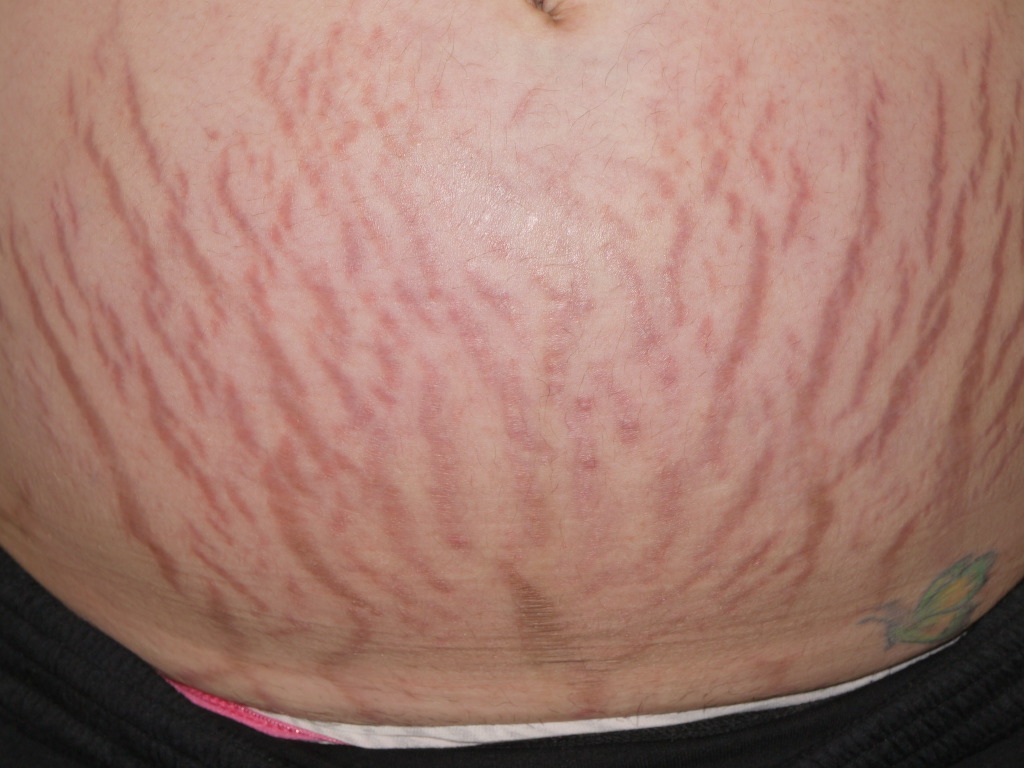[1]
Farahnik B, Park K, Kroumpouzos G, Murase J. Striae gravidarum: Risk factors, prevention, and management. International journal of women's dermatology. 2017 Jun:3(2):77-85. doi: 10.1016/j.ijwd.2016.11.001. Epub 2016 Dec 6
[PubMed PMID: 28560300]
[2]
Al-Himdani S, Ud-Din S, Gilmore S, Bayat A. Striae distensae: a comprehensive review and evidence-based evaluation of prophylaxis and treatment. The British journal of dermatology. 2014 Mar:170(3):527-47. doi: 10.1111/bjd.12681. Epub
[PubMed PMID: 24125059]
[3]
Lurie S, Matas Z, Fux A, Golan A, Sadan O. Association of serum relaxin with striae gravidarum in pregnant women. Archives of gynecology and obstetrics. 2011 Feb:283(2):219-22. doi: 10.1007/s00404-009-1332-5. Epub 2010 Jan 3
[PubMed PMID: 20047054]
[4]
Wang F, Calderone K, Smith NR, Do TT, Helfrich YR, Johnson TR, Kang S, Voorhees JJ, Fisher GJ. Marked disruption and aberrant regulation of elastic fibres in early striae gravidarum. The British journal of dermatology. 2015 Dec:173(6):1420-30. doi: 10.1111/bjd.14027. Epub 2015 Nov 8
[PubMed PMID: 26179468]
[5]
Neve S, Kirtschig G. Elastotic striae associated with striae distensae after application of very potent topical corticosteroids. Clinical and experimental dermatology. 2006 May:31(3):461-2
[PubMed PMID: 16681607]
[6]
Ledoux M, Beauchet A, Fermanian C, Boileau C, Jondeau G, Saiag P. A case-control study of cutaneous signs in adult patients with Marfan disease: diagnostic value of striae. Journal of the American Academy of Dermatology. 2011 Feb:64(2):290-5. doi: 10.1016/j.jaad.2010.01.032. Epub 2010 Nov 26
[PubMed PMID: 21112669]
Level 2 (mid-level) evidence
[8]
Gupta M. Medroxyprogesterone acetate [Depo Provera] injections. Development of striae. The British journal of family planning. 2000 Apr:26(2):104-5
[PubMed PMID: 10773604]
[9]
Picard D, Sellier S, Houivet E, Marpeau L, Fournet P, Thobois B, Bénichou J, Joly P. Incidence and risk factors for striae gravidarum. Journal of the American Academy of Dermatology. 2015 Oct:73(4):699-700. doi: 10.1016/j.jaad.2015.06.037. Epub
[PubMed PMID: 26369842]
[10]
Sheu HM, Yu HS, Chang CH. Mast cell degranulation and elastolysis in the early stage of striae distensae. Journal of cutaneous pathology. 1991 Dec:18(6):410-6
[PubMed PMID: 1774350]
[11]
Zheng P, Lavker RM, Kligman AM. Anatomy of striae. The British journal of dermatology. 1985 Feb:112(2):185-93
[PubMed PMID: 3970840]
[12]
Kasielska-Trojan A, Sobczak M, Antoszewski B. Risk factors of striae gravidarum. International journal of cosmetic science. 2015 Apr:37(2):236-40. doi: 10.1111/ics.12188. Epub 2015 Jan 12
[PubMed PMID: 25440082]
[13]
Hermanns JF, Piérard GE. High-resolution epiluminescence colorimetry of striae distensae. Journal of the European Academy of Dermatology and Venereology : JEADV. 2006 Mar:20(3):282-7
[PubMed PMID: 16503888]
[14]
Forbat E, Al-Niaimi F. Treatment of striae distensae: An evidence-based approach. Journal of cosmetic and laser therapy : official publication of the European Society for Laser Dermatology. 2019:21(1):49-57. doi: 10.1080/14764172.2017.1418515. Epub 2018 Feb 16
[PubMed PMID: 29451986]
[15]
Rawlings AV, Bielfeldt S, Lombard KJ. A review of the effects of moisturizers on the appearance of scars and striae. International journal of cosmetic science. 2012 Dec:34(6):519-24. doi: 10.1111/j.1468-2494.2012.00751.x. Epub 2012 Sep 21
[PubMed PMID: 22994859]
[16]
Ud-Din S, McAnelly SL, Bowring A, Whiteside S, Morris J, Chaudhry I, Bayat A. A double-blind controlled clinical trial assessing the effect of topical gels on striae distensae (stretch marks): a non-invasive imaging, morphological and immunohistochemical study. Archives of dermatological research. 2013 Sep:305(7):603-17. doi: 10.1007/s00403-013-1336-7. Epub 2013 Apr 12
[PubMed PMID: 23579949]
Level 1 (high-level) evidence
[17]
Ud-Din S, McGeorge D, Bayat A. Topical management of striae distensae (stretch marks): prevention and therapy of striae rubrae and albae. Journal of the European Academy of Dermatology and Venereology : JEADV. 2016 Feb:30(2):211-22. doi: 10.1111/jdv.13223. Epub 2015 Oct 20
[PubMed PMID: 26486318]
[18]
Korgavkar K, Wang F. Stretch marks during pregnancy: a review of topical prevention. The British journal of dermatology. 2015 Mar:172(3):606-15. doi: 10.1111/bjd.13426. Epub 2015 Feb 8
[PubMed PMID: 25255817]
[19]
Timur Taşhan S, Kafkasli A. The effect of bitter almond oil and massaging on striae gravidarum in primiparaous women. Journal of clinical nursing. 2012 Jun:21(11-12):1570-6. doi: 10.1111/j.1365-2702.2012.04087.x. Epub
[PubMed PMID: 22594386]
[20]
Elsaie ML, Hussein MS, Tawfik AA, Emam HM, Badawi MA, Fawzy MM, Shokeir HA. Comparison of the effectiveness of two fluences using long-pulsed Nd:YAG laser in the treatment of striae distensae. Histological and morphometric evaluation. Lasers in medical science. 2016 Dec:31(9):1845-1853
[PubMed PMID: 27595152]
[21]
Zaleski-Larsen LA, Jones IT, Guiha I, Wu DC, Goldman MP. A Comparison Study of the Nonablative Fractional 1565-nm Er: glass and the Picosecond Fractional 1064/532-nm Nd: YAG Lasers in the Treatment of Striae Alba: A Split Body Double-Blinded Trial. Dermatologic surgery : official publication for American Society for Dermatologic Surgery [et al.]. 2018 Oct:44(10):1311-1316. doi: 10.1097/DSS.0000000000001555. Epub
[PubMed PMID: 29746426]
Level 1 (high-level) evidence
[22]
Dover JS, Rothaus K, Gold MH. Evaluation of safety and patient subjective efficacy of using radiofrequency and pulsed magnetic fields for the treatment of striae (stretch marks). The Journal of clinical and aesthetic dermatology. 2014 Sep:7(9):30-3
[PubMed PMID: 25276274]
[23]
Hersant B, Niddam J, Meningaud JP. Comparison between the efficacy and safety of platelet-rich plasma vs microdermabrasion in the treatment of striae distensae: clinical and histopathological study. Journal of cosmetic dermatology. 2016 Dec:15(4):565. doi: 10.1111/jocd.12246. Epub 2016 Jun 20
[PubMed PMID: 27320781]
[24]
Bitencourt S, Lunardelli A, Amaral RH, Dias HB, Boschi ES, de Oliveira JR. Safety and patient subjective efficacy of using galvanopuncture for the treatment of striae distensae. Journal of cosmetic dermatology. 2016 Dec:15(4):393-398. doi: 10.1111/jocd.12222. Epub 2016 Apr 19
[PubMed PMID: 27090205]
[25]
Aust M, Walezko N. [Acne scars and striae distensae: Effective treatment with medical skin needling]. Der Hautarzt; Zeitschrift fur Dermatologie, Venerologie, und verwandte Gebiete. 2015 Oct:66(10):748-52. doi: 10.1007/s00105-015-3662-5. Epub
[PubMed PMID: 26251169]
[26]
Kravvas G, Veitch D, Al-Niaimi F. The use of energy devices in the treatment of striae: a systematic literature review. The Journal of dermatological treatment. 2019 May:30(3):294-302. doi: 10.1080/09546634.2018.1506078. Epub 2018 Sep 7
[PubMed PMID: 30049244]
Level 1 (high-level) evidence
[27]
Gamil HD, Ibrahim SA, Ebrahim HM, Albalat W. Platelet-Rich Plasma Versus Tretinoin in Treatment of Striae Distensae: A Comparative Study. Dermatologic surgery : official publication for American Society for Dermatologic Surgery [et al.]. 2018 May:44(5):697-704. doi: 10.1097/DSS.0000000000001408. Epub
[PubMed PMID: 29701622]
Level 2 (mid-level) evidence

